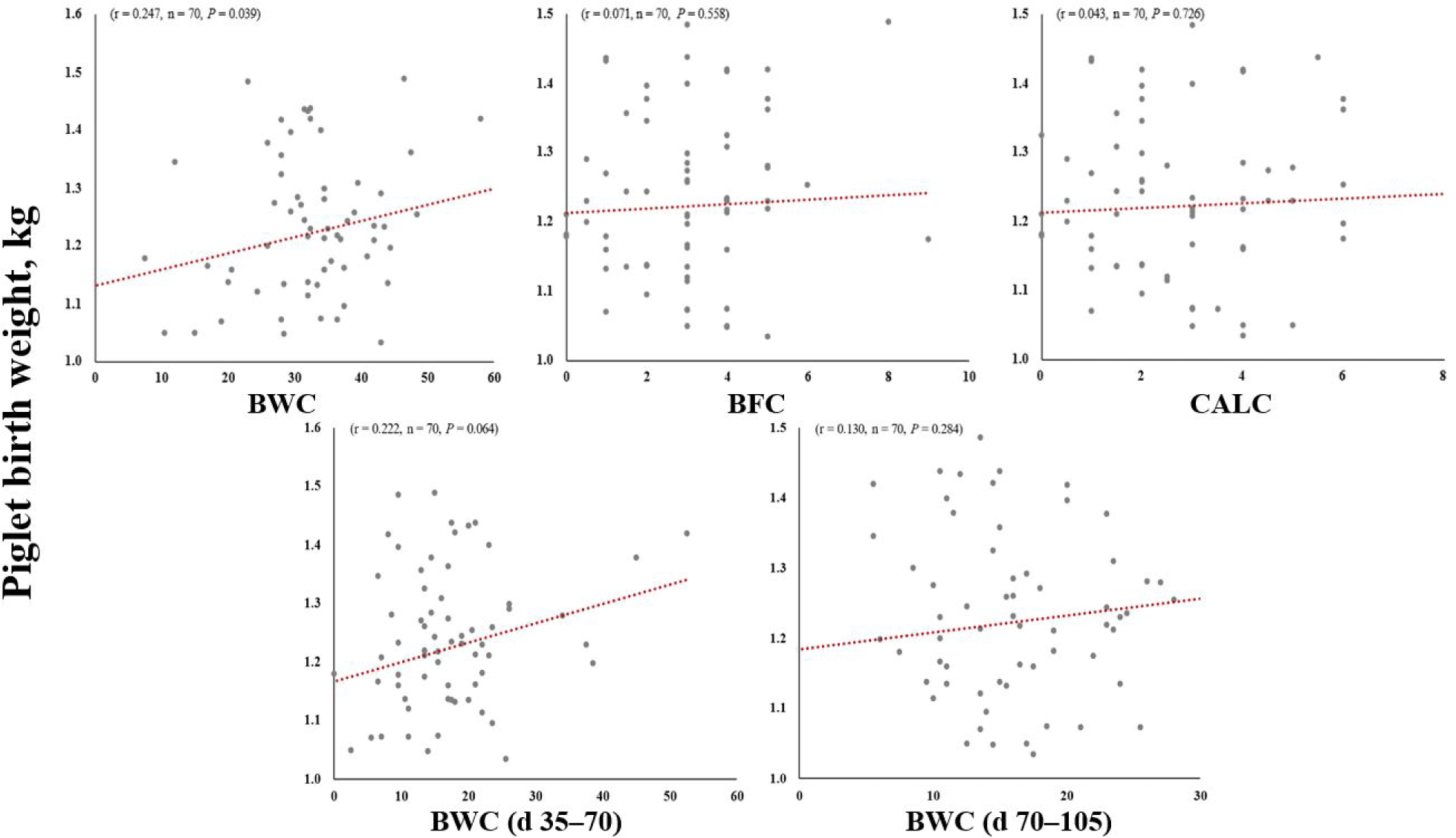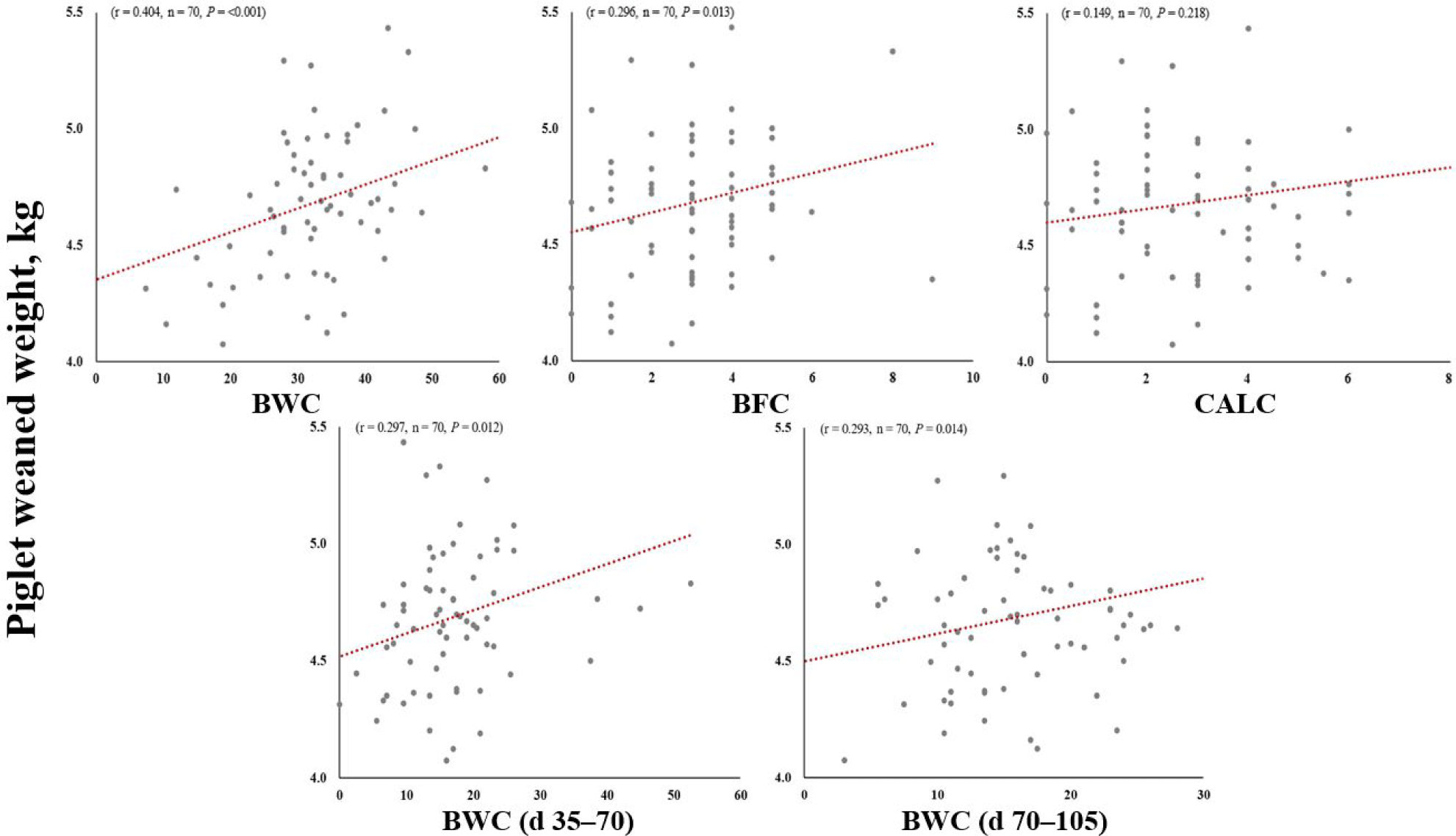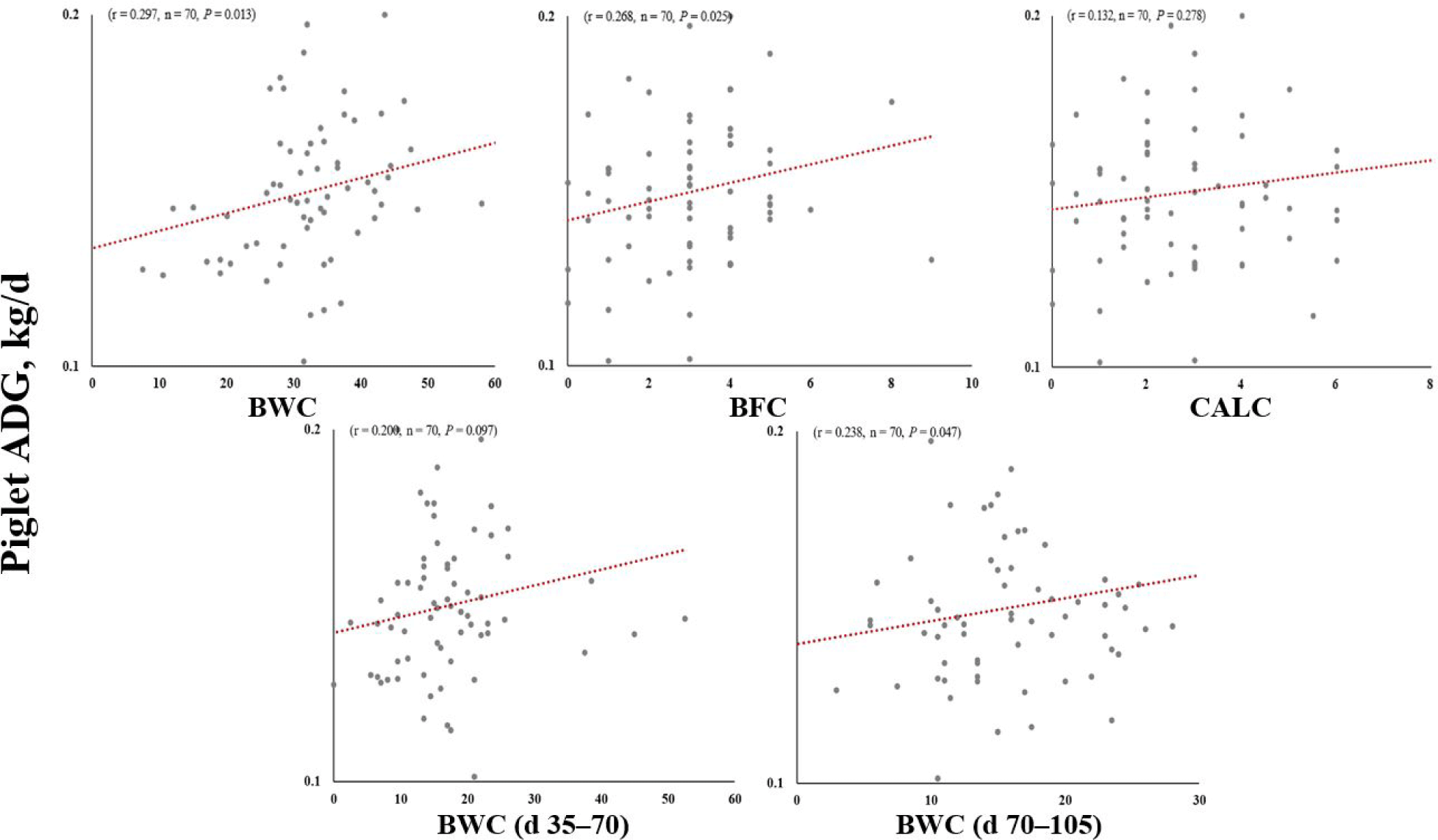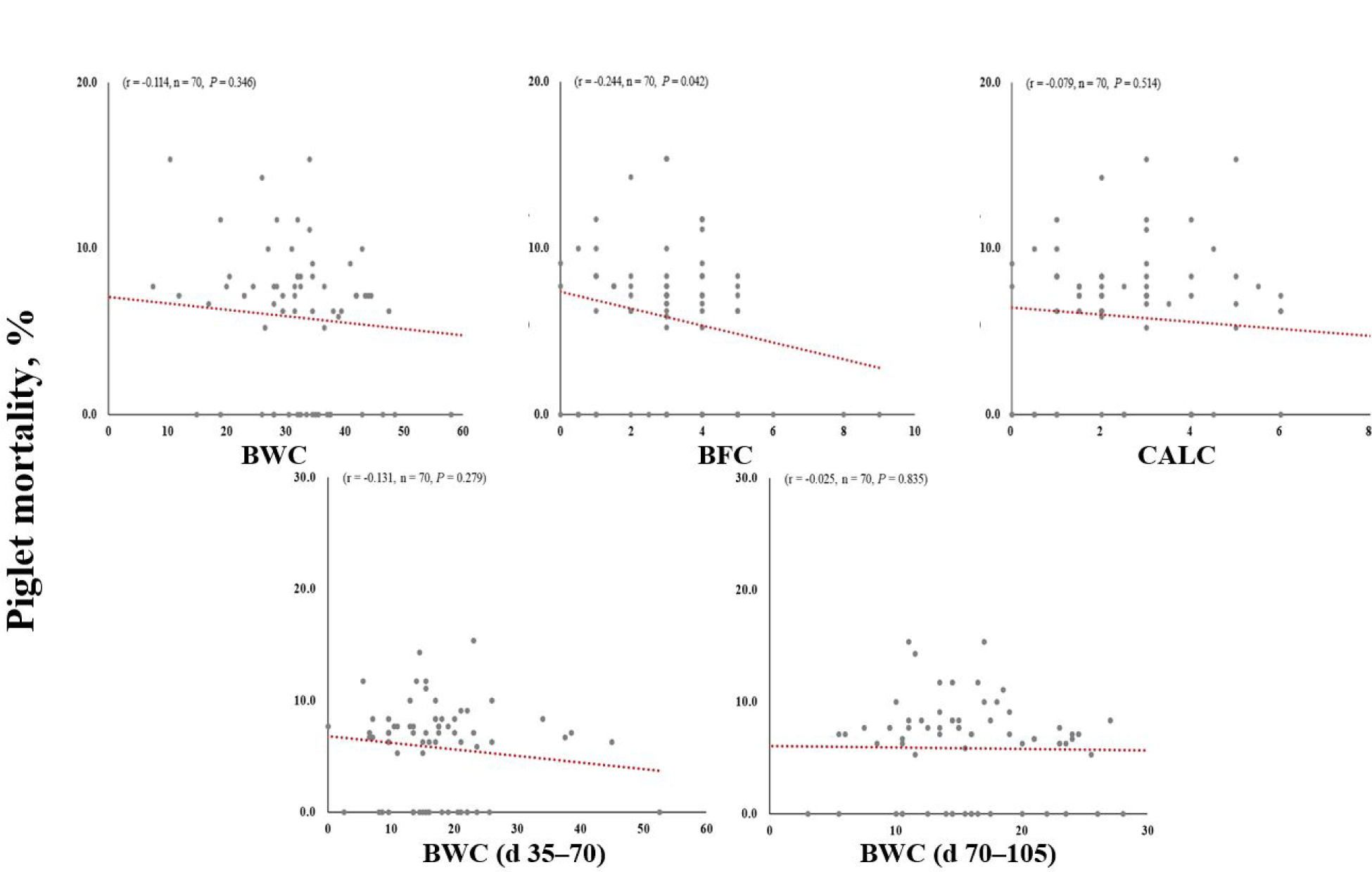INTRODUCTION
Understanding the alterations in sow body characteristics during crucial intervals is pivotal for optimizing reproductive performance and enhancing the efficacy and profitability of swine production [1-3]. Variations in sow body characteristics can serve as health indicators, management markers, and indicators of feed intake status [4]. Such changes are predominantly dependent on feed intake, a critical factor for livestock animals. There are several methods to assess a sow’s body condition, including backfat thickness changes (BFC), caliper score changes (CALC), body condition score and body weight changes (BWC). These parameters offer valuable insights into the sow’s nutritional status, body condition, and energy accumulation, all of which can influence the sow’s capacity to support fetal growth and lactation after birth [5,6]. BWC is a significant indicator for management adjustments. The primary controller of body weight is feed intake. Historically, efforts have been made to improve sow condition and piglet performance by regulating feeding strategies [4,7,8]. Numerous studies report that sows with high feed intake and substantial weight mobility during gestation yield larger litter sizes and superior growth performance [9,10]. Sows experience a consistent increase in weight during gestation for various reasons, including recovery, growth, fetal development, and uterine expansion. Hence, monitoring these body characteristics at farrowing time can help identify potential health issues and nutritional deficiencies, which could affect feed intake [8,11,12].
Throughout the lactation period, sows produce milk for their litters, utilizing the stored energy. Various studies indicate that sows experience significant body loss when considerable changes occur during gestation [13-15]. Some reports suggest that milk production increases when sows endure greater body weight and backfat loss [10,11,15]. However, excessive body feature loss can have a negative impact on reproductive performance and the weaning to estrus interval (WEI) [16,17]. This effect is particularly noticeable in young sows, which often display reduced farrowing rates and piglet growth, attributable to insufficient recovery [18]. Therefore, managing sow body characteristics is crucial for optimizing sow productivity and reproductive success.
Recent studies have suggested the underestimation of the early and mid-stages of gestation. Certain reports indicate that effective management during early gestation can have a positive impact on piglet birth rates, mortality, and growth [5,19]. Evidence suggests that high feed intake during the early gestation period can help ensure an appropriate composition of body conditions at farrowing and weaning [5,20]. The importance of early-stage feeding strategies has been emphasized, proposing that BFC should be sufficiently replenished during early gestation [21].
For several decades, the late gestation period was considered the most effective for piglet performance. However, numerous studies have shown that the early to mid-term gestation periods are more crucial for fetal growth and survival than the late gestation period. Therefore, this experiment was designed to determine which gestation period has the most substantial impact on sow performance and reproductive outcomes by analyzing sow BWC throughout different stages of pregnancy.
MATERIALS AND METHODS
The protocol for this study was approved by the Institutional Animal Care and Use Committee (IACUC) of Rural Development Administration (No. NIAS-2022-554). The experiment was conducted in a commercial farm, located in Ham-an, Kyung sang nam-do, Republic of Korea. In all, 1,725 sets of data from 70 crossbred sows (Landrace × Yorkshire, parity ranged from 1 to 9) with the average litter size of 14.11 were taken. The BWC, BFC, and CALC were measured on days 35, 70, and 105 of gestation and at the weaning period (21-day of lactation). The management protocol was according to Kim et al. [22]. Briefly, artificial insemination was performed two times after the onset of estrus, and pregnancy was confirmed at day 30 post-breeding using an ultrasonic device (Agroscan A16, Echo Control Medical, Angouleme, France). During gestation, all sows were housed in individual gestation stalls (2.05 × 1.08 m) with fully slatted concrete flooring. On day 105 of gestation, all sows were moved to farrowing crates (2.14 × 2.15 m). Each crate had a single feeder, and water was always available through a nipple drinker. Room temperature and relative humidity located at a sow’s head level were recorded using a temperature/humidity data logger (TM-305U, Tenmars Electronics, Neihu, Taiwan), and skilled workers were recorded daily. The average ambient temperature was kept between 17°C and 22°C and relative humidity range between 53.8% to 96.9% (average of 61.1%) was recorded. After farrow, a heated lid (35°C) equipped with a feeder and nipple trough for the sow, and two water nipples for the piglets were used to house and separate sows until their offspring was weaned at 3 weeks. At this point, both the sows and piglets were switched to a lactation diet, which was provided ad libitum until weaning. During the lactation period, feed intake was recorded and used for calculating average daily feed intake (ADFI) during lactation. After weaning, all of the individual data were categorized according to gestation days (days from 35 to 70, 70 to 105, and 35 to 105) and re-grouped as BWC during d 35 to 70 (BWC low and high), and 70–105 (BWC low and high) based on BWC. After sows were moved from the delivery room, the WEI was measured, which was days taken from weaning to until re-estrus.
The BWC, BFC, and CALC were measured using CIMA control pig (CIMA, Correggio, Italy), ultrasonic device (Agroscan A16, Echo Control Medical), caliper measurer (Purina, Richmond, IN, USA), respectively, at day 35, 70, 105 of gestation and weaning (21 d of lactation period). The BWC, BFC, and CALC were measured by the difference of between the sampling times. The BFC was measured on 65 mm to the left side of the dorsal mid-line at the level of the last rib (P2).
After farrowing, litter traits recorded including the number of totally piglet born and born alive, stillborn, number of piglets weaned and mortality. Piglet and litter’s weight measurement was taken at birth and weaning period. To calculate average daily gain (ADG) of piglet and litters, calculated as the difference between the weaning and initial weights, divided by the number of days from birth to weaning, and multiplied by the number of piglets weaned.
All of data were collected for each sow and analyzed by GLM procedure using the SAS statistical software (SAS Institute– Cary, NC, USA) to determine the mean and standard deviation of the parameters. A 2 × 2 factorial arrangement was considered according to body weight differences for day 35 to 70 (high, 16.85 < kg; low, 16.85 > kg) and day 70 to 105 (high, 15.75 <; low, 15.75 >) as main effects. The Tukey’s honestly significant difference test partitioned significant differences and interactions between the treatment means at the 0.05 statistical level, and 0.05 to 0.10 was regarded as a trend towards significance. An individual sow was used as an experimental unit for analysis of all variables. Spearman correlation was utilized to assess the relationships between the changes in body features, such as BWC or BFC, and CALC, which are factors associated with performance in lactating sows and their litters. This evaluation was conducted with a false discovery rate (FDR) threshold of less than 0.05. To control for the risk of false positives in multiple comparisons, a FDR correction was applied. This approach was implemented to balance the detection of significant findings against the risk of type I errors, with a set FDR threshold of less than 0.05.
RESULTS
Table 1 displays the changes in sow body characteristics in accordance with sow BWC during the gestation period. The results highlight significant differences in sow BWC from day 35 to day 105 (p < 0.001) of gestation, with the highest BWC recorded between day 35 to day 70. However, no significant differences were observed for BFC, CALC, feed intake (FI) during lactation, and based on BWC between day 35 and day 70 of gestation. An increase in sow BWC from day 70 to day 105 was significantly associated with an increase in BFC from day 35 to day 70 (p < 0.001), from day 70 to day 105 (p = 0.033), and from day 35 to day 105 (p < 0.001). Similarly, CALC from day 35 to day 70 (p = 0.009) and from day 35 to day 105 (p = 0.020) also increased when sow BWC was higher from day 70 to day 105. However, no significant difference was detected in FI during lactation and WEI.
Table 2 demonstrates reproductive performance differences according to sow BWC during the gestation period. An increase in sow BWC from day 35 to day 70 was significantly associated with a decrease in piglet mortality (p = 0.046) and an increase in piglet birth weight (p = 0.032). There was also a trend indicating increased piglet body weight at weaning (p = 0.055) and ADG (p = 0.067) when sows had a higher BWC from day 35 to day 70. No significant differences were observed concerning the number of total piglets born, stillborn, born alive, weaned piglets, litter weight at birth and weaning, and ADG relative to BWC from day 35 to day 70 of gestation. Higher sow BWC from day 70 to day 105 was significantly associated with decreased mortality (p = 0.032), and increased litter ADG (p = 0.038). A trend was detected indicating an increase in the total number of piglets born (p = 0.070) and piglet ADG (p = 0.071) when sows experienced a higher BWC from day 70 to day 105. No significant differences were detected for the number of stillborn, born alive, weaned piglets, litter and piglet weight at birth and weaning relative to BWC from day 70 to day 105. No interactional differences were observed concerning reproductive performances, although a trend was detected suggesting that high BWC improves piglet mortality (p = 0.070) and ADG (p = 0.086).
Fig. 1 depicts the correlation between sow body characteristics and piglet birth weight. The results indicate that sow BWC is positively related to piglet birth weight with a significant difference (r = 0.247, n = 70, p = 0.039). Also results reveal a trend where sow BWC at day 35 to 70 is positively related to piglet birth weight (r = 0.222, n = 70, p = 0.064). However, no associations were found between sow BWC from day 70 to 105, BFC and CALC during gestation and piglet birth weight.

Fig. 2 presents the correlation between sow body characteristics and piglet weaned weight. The results suggest that both sow BWC (r = 0.404, n = 70, p < 0.001) and BFC (r = 0.296, n = 70, p = 0.013) are positively related to piglet weaned weight with significant differences. Sow BWC at day 35 to 70 (r = 0.297, n = 70, p = 0.012) and at day 70 to 105 (r = 0.293, n = 70, p = 0.014) are both positively related to piglet weaned weight with significant differences. However, no associations were found between sow CALC during gestation and piglet weaned weight.

Fig. 3 illustrates the correlation between sow body characteristics and piglet ADG. The results suggest that sow BWC (r = 0.297, n = 70, p = 0.013) and BFC (r = 0.268, n = 70, p = 0.025) are positively related to piglet ADG with significant differences. Also results suggest that sow BWC at day 70 to 105 is positively related to piglet ADG with a significant difference (r = 0.238, n = 70, p = 0.047). Furthermore, a positive trend was observed where BWC from day 35 to 70 was positively related to piglet ADG (r = 0.200, n = 70, p = 0.097). No associations were identified between sow CALC during gestation and piglet ADG.

Fig. 4 presents the correlation between sow body characteristics and piglet mortality. The results show that sow BFC (r = −0.244, n = 70, p = 0.042) is negatively related to piglet mortality with a significant difference. However, no associations were found between sow BWC and CALC during gestation and piglet mortality.

DISCUSSION
The significant changes in sow body characteristics during gestation cannot be overstated, given their profound impact on the performance of both the sows and their offspring. Research has largely concentrated on modifications in sow BWC during late gestation, a period associated with peak fetal growth. A positive correlation has been established between litter weight and sow BW at the end of gestation [23]. The effects of BWC at various stages of gestation on reproductive performance and litter traits have also been extensively investigated [1,5]. Recently, the impact of mid-gestation changes has come under the spotlight. Greater BWC early and mid-gestation has been linked to larger litter sizes and weights at birth. However, late gestation significant BWC appears to yield higher litter weights both at birth and weaning [23]. Given its importance for mammalian gland development and fetal muscle growth, mid-gestation feeding strategies were traditionally adjusted according to the sow’s body condition. Increased feed intake during mid-gestation could reportedly improve progeny secondary fiber development [24]. This period has been related to the fetal fiber number, which in turn, correlates with birth weight [22]. Several studies have underscored the vital role of piglet birth weight, highlighting a relationship between piglet birth weight and mortality [13,25]. It was reported that birth weight significantly influences piglet growth, feed conversion ratio and the time required to reach market weight [26,27]. Our results suggest that sow BWC from day 70 to 105 of gestation positively impacts birth weight and ADG, indicating that BWC during this period could contribute to fetal secondary fiber development and nutrient accumulation during gestation for lactation.
However, the extent of weight gain during gestation might have varying effects on piglet mortality rates [13]. In our study, although there was no significant difference in mortality, a slight decrease was observed in the higher BWC group. This could be due to the accumulation of backfat thickness (BF). The BF indicates the energy status of sows. Less BF accumulation during gestation may reduce milk production and recovery during the lactation period [10,15]. As reported by Thongkhuv et al. [11], BF is positively related to milk yield during lactation. Therefore, reduced BF accumulation during gestation may negatively affect piglet performance and hinder sow recovery and WEI.
During the gestation period from day 35 to 70, the lower BWC group exhibited higher mortality. This outcome could be attributed to diminished nutrient accumulation during gestation. In result of Wang et al. [6], sows with less BWC during gestation had lower colostrum and milk protein and fat content. However, Mallmann et al. [28] reported no notable difference in reproductive performance during this stage. As a result of these varied outcomes, a more in-depth examination is required to understand the relationship between sow BWC and reproductive performance in relation to gestational weight gain.
Numerous studies have been conducted to investigate the effects of sow BWC during gestation on reproductive performance and litter outcomes. Strathe et al. [10] discovered that sows with higher BWC during gestation had increased milk production and piglet growth rates, leading to higher weaning weights and reduced pre-weaning mortality rates. Another study by Gonçalves et al. [29] examined the effects of different feeding strategies on sow BWC during gestation and their impact on litter outcomes. Similarly, a study by Lavery et al. [30] investigated the effects of sow BWC and BFC during gestation on reproductive performance. They found that sows with higher BWC and BFC during early and mid-gestation had larger litter sizes and higher birth weights. Conversely, some of results indicate that excessive BWC during gestation could negatively affect reproductive performance and litter outcomes, as it increased stillbirth rates and decreased piglet birth weights [31,32]. In summary, these studies suggest that managing sow BWC during gestation can significantly influence litter outcomes and reproductive performance. However, the optimal BWC and feeding strategies may vary based on factors such as sow genetics, parity, and environmental conditions [15].
Numerous studies have probed the relationship between sow BWC during gestation and piglet production performance [8,28]. Hypothetically, sows with higher BWC during this period may produce larger litters, which could result in a decrease in individual piglet weight at weaning [33]. However, this study did not detect a relationship between sow BWC and litter size. The connection between sow BWC during different gestation periods and piglet birth weight has been the focus of various studies, suggesting that maternal nutrition during late gestation is instrumental for piglet birth weight.
In terms of piglet ADG, our study discerned a positive correlation between sow BWC during days 70 to 105 and 35 to 105 of gestation. This outcome echoes the findings of Mallmann et al. [28], who posited that maternal BWC during gestation can positively impact piglet growth and development. Zhou et al. [8] further reported that enhanced maternal nutrition during late gestation augmented piglet growth performance. These findings underscore the crucial role of maternal nutrition during gestation for piglet growth and development. Additionally, several factors, such as parity, litter size, and season, have been identified to influence sow BWC during gestation. Wang et al. [33] reported that litter size considerably affected sow BWC during gestation, with sows carrying larger litters experiencing more significant BW loss. Pedersen et al. [17] mentioned that BW loss can be larger due to produce higher milk for feeding large litters and usage for maintain their energy requirement.
Multiple studies have examined the correlation between sow BWC during gestation and piglet mortality, although results vary. Some studies found a negative association between sow BWC during gestation and piglet mortality, while others found no significant relationship. Li et al. [19] discovered that sows with higher BWC during late gestation had a lower risk of piglet mortality, potentially due to enhanced milk production and nutrient transfer to piglets. Nonetheless, Vernunft et al. [23] found no significant association between sow BWC during gestation and stillborn, but did find a positive correlation between sow BWC and litter weight at birth. As a result, other factors not considered in these studies may influence this relationship.
According to our correlation analysis, the most influential factor affecting piglet birth weight was sow BWC during gestation. In particular, sow BWC during days 35–70 significantly influenced piglet birth weight, compared to sow BWC during days 70–105. Our results further demonstrated that sows with higher BWC during days 35–70 produced piglets with higher birth weight. Additionally, the weight at weaning and the ADG of piglets were also found to increase, correlating with higher sow BWC during the same period. The introduction of hyper-prolific sows has led to an increase in the number of piglets born; however, their low birth weight presents a significant challenge to address. It is well-established that piglets born with higher weights experience greater weight gain, consume more feed, and exhibit lower mortality [27]. Therefore, lower sow BWC during days 35-70 might contribute to reduced growth in piglets, attributed to the disadvantages of low birth weight.
On the other hand, our correlation analysis found that weaning weight is affected not only by BWC but also by sow BFC. Sow BFC serves as an indication of energy accumulation in pigs. Previous studies have reported a relationship between BFC and piglet performance [4,11]. The BFC also plays a critical role in determining the characteristics of colostrum and milk, contributing to the production of more beneficial nutrients in milk and supplying energy for milk production [11,34]. Furthermore, milk production has been reported to be positively associated with high body BWC, possibly due to increased feed intake, which affects sow nutrient accumulation, leading to more milk production [6,9]. Although we did not investigate milk profiles in our study, we can hypothesize that the body reserves in mid-late gestation may influence milk production. Our results also indicated that BFC is negatively associated with mortality. This might be due to its influence on milk production and nutrient profiles [35]. Similarly, result of Thonkhuy et al. [11] shows high BFC of sows at late gestation have better reproduction performances and milk yield.
CONCLUSION
BWC during gestation constitute a crucial factor in swine production, significantly influencing reproductive performance and litter growth. Our results demonstrate that sows displaying higher BWC during gestation have a positive correlation with reproductive performance, which in turn enhances piglet birth weight, growth, and survivability. Notably, sow BWC during the day 35 to 70 period displayed a positive correlation with piglet birth weight and a negative correlation with mortality, while sow BWC during the 70–105 day period seemed to contribute to an increase in the total number of piglets born. Based on our findings, we propose that improving piglet growth and survivability could be achievable by enhancing sow BWC during the earlier phase of gestation. Nevertheless, further research is needed to pinpoint the precise factors affecting sow health and reproductive performance. This will ensure more targeted strategies for promoting better outcomes in swine production.
















